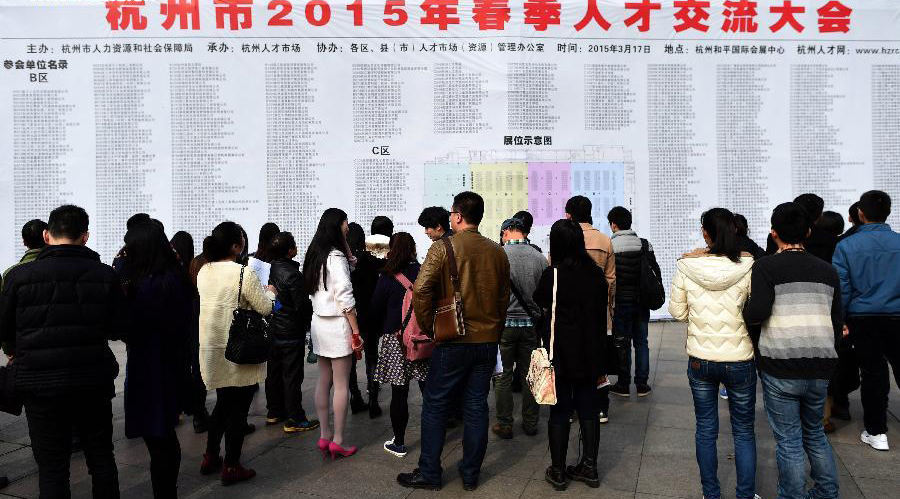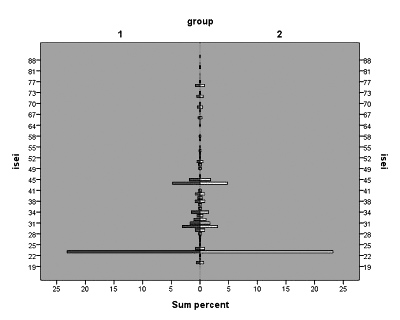China’s changing social structure

Job seekers view employment opportunities, many in technical fields, at a job fair earlier this year in Hangzhou, Zhejiang Province. According to data from the fifth and sixth national censuses, the ratio of technical workers in China’s labor market dropped from 2000 to 2010.

Social structure reflected in the International Socio-economic Index (ISEI) percentage, according to the data from the sixth national census (2010)
A comparison of data from the fifth and sixth national censuses shows that China’s social structure is gradually changing, showing a trend toward increased upward social mobility.
The fifth national census in 2000 indicated that China’s society had an inverted T-shaped social structure, reflecting the huge number of people from low socioeconomic backgrounds and a fledgling middle class.
Analysis of data from the sixth national census in 2010 showed that great changes have taken place in China’s social structure, which is reflected in changes to four big groups.
Shift from farming
Measured using the International Socio-economic Index (ISEI), farmers had a score of 23 points and accounted for 46.49 percent of the population in 2010, down 16.71 percent from 63.2 percent in 2000.
Such a drastic change over a decade shows enormous social progress. It can be predicted that a similarly huge transition to the social structure will be reflected in the next national census.
This transition reflects a general tendency of industrialization and urbanization. According to sociology, an agricultural labor force accounting for less than 30 percent of the total labor force is an important indicator of a modernized social structure.
There are three reasons why the number of Chinese farmers is sharply decreasing. First, rural land once used for agriculture is being acquired for urban construction amid accelerating urbanization. Second, farmers are finding work in other fields. Most of them are young laborers, who are unlikely to return to their hometowns. Indeed, the sixth census showed a declining ratio of rice farmers compared to previous data. Third, rural areas are being urbanized.
A recent survey found that a high ratio of farmers who stay in the countryside don’t engage in agricultural productive labor. Their housing is also changing. In villages and surrounding areas, non-agricultural industries are very advanced and most farmers work in industrial, service or commercial sectors. These villages are no longer different from towns.
In addition, there are various reasons for acquiring city hukou (household registration). These include enrolling at city universities, buying houses in towns for children to get better education and better access to health care for the elderly. Data from Tsinghua University shows that 21.6 percent of Chinese citizens with rural hukou have purchased houses in towns.
Increase in manual laborers
As a group mainly engaged in the industrial and manufacturing sectors, manual laborers accounted for between 29 and 32 points based on ISEI calculations. They covered 9.8 percent in 2000 and 13.58 percent in 2010, rising by 3.78 percent.
From the perspective of occupational status, manual laborers belong to the blue-collar group and are not included in the middle class. However, it is the most important labor group in all countries around the world. This group covers between 10 percent and more than 20 percent even in economically developed countries, where modernization has been accomplished. It will therefore occupy an important position in China’s future social structure and still be the most important group pushing forward China’s economic and social development.
Blue-collar workers, as the most typical industrial workers and the most basic group in the working class should be respected in society. With their work characterized by great labor intensity and risks, their income should be improved. In some developed countries, the income of this group is no less than the middle class and even higher due to the powerful force of labor unions.
This group will occupy a steady proportion of China’s labor force for decades to come. However, it will shrink somewhat in the coming post-industrial society.
Technical workers down
This group is mainly concentrated between 33 and 40 points based on ISEI calculations, including land and water transportation staff and assembly operators of mechanical and electrical products. It covered 9.8 percent in 2010 and 11.2 percent in 2000, declining by 1.4 percent.
It is worth pondering that the ratio of technical workers didn’t increase, but dropped. This group is between the white-collar and blue-collar class and is an important source of the middle class. Manual laborers may enter the middle class through improving their techniques.
The system of China’s technical certification has curbed the promotion of technical migrant workers’ social status, which was verified once again by the comparison between the fifth and sixth census data.
Currently, there are sharp contradictions in this aspect. China’s technical workers are severely insufficient. They are urgently needed in employment markets. Furthermore, technical workers are not respected enough in society. They face discrimination in technical certification, status authentication and vocational training.
White-collar workers boom
White-collar workers and the middle class are almost synonymous in sociological studies. White-collar workers comprise four groups: administrators, professional technical staff, sales personnel and office workers. The two former groups usually have a university education. ISEI scores show that the two groups didn’t change much between 2000 and 2010.
The number of sales personnel and office worker, however, rapidly increased over this decade. With 43 and 45 points in ISEI, the two groups accounted for 2.9 percent in 2000 and 13.34 percent in 2010, up 10.44 percent. Most of them are mid-low white-collar workers.
Data from the sixth census indicated that 58.2 percent of this group were rural hukou holders, or born into farming families. Farmers who have accumulated small capital usually engage in small business. A new channel for promoting farmers’ status has therefore been created.
People in this class typically have limited education. They are mainly graduates of middle or high schools. Those who graduate from senior or lower schools accounted for 83.1 percent of all business operators. The main channel for such people to enter the middle class is therefore not the educational channel. This group is open enough to accept people from all classes. In practice, many who are hindered by hukou restrictions or find it difficult to advance through education hope to change their social status through business.
Living in towns, this group struggles with great enterprise to achieve a higher status. They are an important source of China’s economic and social vitality, yet they are usually left by the wayside in terms of social management and hukou policy.
A comparison of the fifth and sixth census in ISEI social structure found that lower-class groups are apparently upwardly mobile and some groups in the middle class are enlarging.
However, the graph of general social structure shows that China’s social structure is still similar to an inverted T shape. Some groups in the middle class have enlarged to some extent, but the overall social structure hasn’t fundamentally changed. The middle class still occupies a small proportion of the whole society.
Li Qiang is a professor from the School of Social Sciences at Tsinghua University.
